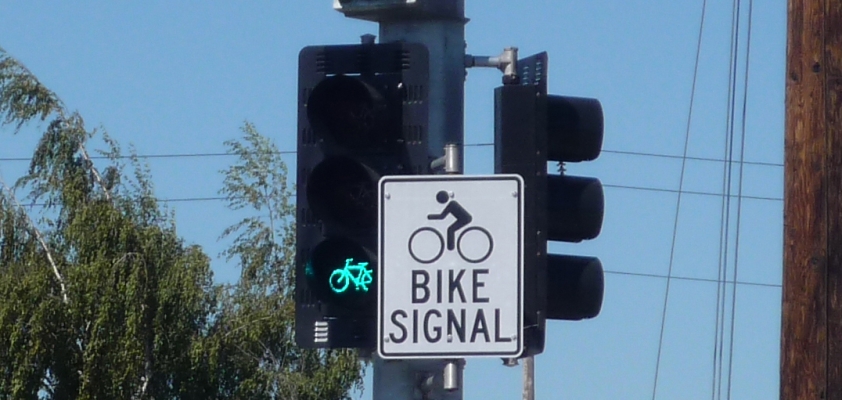Translating Bike Traffic Signals: PSU Researchers to Identify Gaps in Driver Comprehension in New NCHRP Study

THE NEW PROJECT
Portland State University is embarking on a collaborative research effort, funded by the National Cooperative Highway Research Program (NCHRP), to help road users better understand bike-specific traffic signals. Over the next year, Dr. Christopher Monsere and Dr. Sirisha Kothuri of PSU's Transportation Research and Education Center (TREC) will work with researchers from Oregon State University and Toole Design Group to identify gaps in driver comprehension and causes of confusion when both bike signals and motor vehicle signals are present.
A previous TREC study led by Dr. Monsere, Operational Guidance for Bicycle-Specific Traffic Signals, contributed to an interim approval for "Optional Use of a Bicycle Signal Face" (IA-16) issued by the Federal Highway Administration (FHWA) in December 2013. Following this interim approval, the number of U.S. installations of bicycle-specific traffic signals has steadily increased. Over 40 state and local highway agencies have requested approval to install bicycle signal faces under IA-16. There are currently over 490 identified intersections in the U.S. (193 of them in New York City alone) with bicycle signals. The motivation for this new research is to develop a better understanding of how and when drivers confuse bicycle signal faces with the circular signals intended for cars.
THE ISSUE
The complexity of signalized intersections, especially in busy urban settings with multimodal users, requires that traffic engineers and designers think carefully about the interactions of all modes. Bicyclists are vulnerable road users, and conditions sometimes dictate that their timed movements through an intersection be separated for safety reasons. If a traffic signal design isn’t self-explanatory, it needs to be revised.
Recent installations in Seattle, Washington and Brooklyn, New York have drawn attention to driver confusion with bicycle signal displays. In both of these cases, the bicycle signal face was not separated by the 3-foot vertical or horizontal separation that the FHWA recommends. In Seattle, a subsequent project included upgraded signals infrastructure with mast arms that allowed the separation of the signal heads, which improved driver understanding of the signal displays. Approach and design vary with each installation, and further guidance is needed.
However, the different possible sources of driver confusion over bike-specific traffic signals are not well established. Issues that could be contributing to confusion include:
- the proximity of bicycle and motor vehicle signal faces,
- confusion of the bicycle symbol for the green circular indication at distance,
- poor comprehension of the bicycle signal face, or
- the strong similarities between other aspects of the bicycle and vehicle signals.
THE TEAM
- Christopher Monsere, Ph.D., P.E., Professor & Chair (Principal Investigator)
- Sirisha Kothuri, Ph.D., Senior Research Associate
- David Hurwitz, Ph.D., Associate Professor & Director of Driving and Bicycling Simulator Laboratory
- Hagai Tapiro, Ph.D., Post-Doctoral Research Associate
- Christina Fink, P.E., Senior Traffic Engineer
- Hannah Pritchard, P.E., PTOE, Senior Traffic Engineer
- Bill Schultheiss, P.E., Vice President, Director of Sustainable Safety
RESEARCH OBJECTIVES
- To summarize and synthesize the U.S. experience with bicycle signal face installations (results will provide useful information for agencies considering the use of bicycle signal faces).
- To identify any remaining gaps in understanding driver comprehension and compliance and describe how they can be effectively addressed through further research (results will be useful for those funding research to improve guidelines and standards for bicycle traffic signals).
WHAT’S NEXT?
The research team will conduct interviews with key staff at agencies that have installed bicycle signal faces, to further refine the team’s understanding of the research needs. One product of this study will be a list of prioritized research topics with a recommended approach and general methodology for each (for example, detailed crash analysis; field study using video analysis, intercept surveys and observation data; human factors studies using a driving simulator; or some combination of methods).
This work stands to improve practitioners' understanding of human factors that affect comprehension of signals, including visual acuity, contrast sensitivity, color perception, and expectations.
This research was funded by the National Cooperative Highway Research Program (NCHRP), with additional support from Portland State University, Oregon State University, and Toole Design Group.
RELATED RESEARCH
To learn more about this and other transportation research, sign up for our monthly research newsletter.
- Operational Guidance for Bicycle-Specific Traffic Signals
- Addressing Bicycle-Vehicle Conflicts with Alternate Signal Control Strategies
- Improving Walkability Through Control Strategies at Signalized Intersections
The Transportation Research and Education Center (TREC) at Portland State University is home to the National Institute for Transportation and Communities (NITC), the Initiative for Bicycle and Pedestrian Innovation (IBPI), and other transportation programs. TREC produces research and tools for transportation decision makers, develops K-12 curriculum to expand the diversity and capacity of the workforce, and engages students and young professionals through education.
